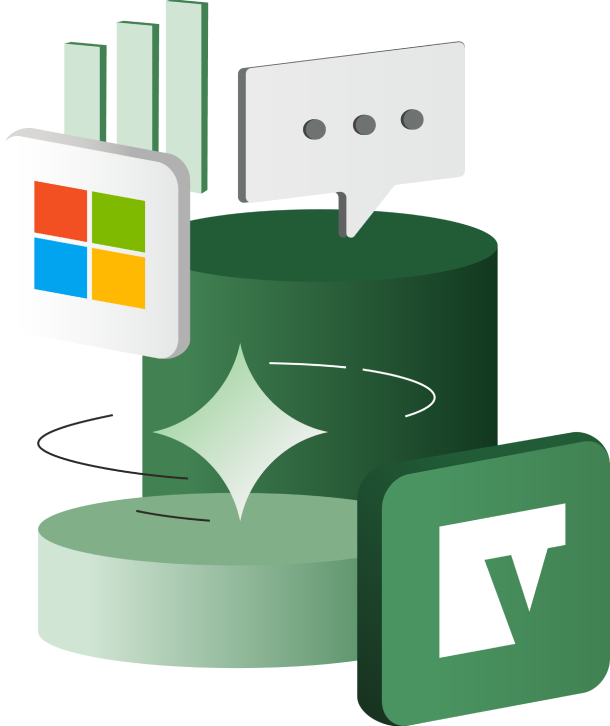Product
Vena Copilot AI Agents: Meet the Analytics and Reporting Agents
See how Vena Copilot’s AI agents, the Analytics and Reporting Agents, can help revolutionize your FP&A processes by automating manual tasks and delivering real-time insights.

Preparing forecasts. Putting together decks of analysis for C-suite presentations. A relentless stream of deadlines. Last-minute requests for revenue analysis.
Life as a member of a finance team can feel like you’re living out a Greek myth—like Sisyphus, eternally rolling a boulder up a hill, only to watch it roll back down.
While trying to crunch all the numbers and sift through the data, an FP&A professional also needs to make sure that everything is above board—that there are no mistakes, no miscues and no bad calculations that can cause delays.
Traditionally, that’s meant that finance teams need to tread carefully, not only when completing their tasks at hand, but also when adopting new tools they don’t know if they can completely trust.
That might be why a whopping 94% of CFOs still had not brought AI into their finance and accounting operations as of early 2024, according to Nick Araco Jr., the CEO of The CFO Alliance. “They’re sticking their toes in the water,” he said, “but they’re not there yet.”
With generative AI being a new and burgeoning field, that’s a valid stance for CFOs to take. It’s also one that we took seriously when building our new product, Vena Copilot.
Vena Copilot, our new generative AI assistant purpose-built for FP&A, is a tool that finance teams can trust to produce accurate outputs and insights, allowing them to maximize their productivity. Vena Copilot is built on Microsoft’s world-class generative AI technology, Azure Open AI, and is driven by your specific organization’s data.
Here’s how we built it—with finance teams in mind.
“Vena Copilot allows you and all of your business stakeholders to interact with all your financial and operational data in the most natural format ever, which is human language,” said Andrew Stanbridge, Vena’s VP of Product, at Vena’s Excelerate Finance 2024 event in Nashville in May.
“It’s a conversational interface,” he explained, and anyone—even those outside of core finance teams—can interact with it in a very intuitive way. In effect, Vena Copilot is a tool that acts much like a translator of financial and operational data. It can help tell stories, uncover narratives, decipher the meaning behind financial data and trends and put this information directly into the hands of stakeholders and decision-makers.
Vena Copilot does this by:
Leveraging best-in-class Microsoft Azure Open AI models, specifically trained to understand hundreds of common FP&A problems.
Allowing you to customize your own AI models based on your business’s unique needs, getting “smarter” over time.
Working seamlessly with Microsoft 365—powering your work within Excel and PowerPoint through Vena's native integration, where you can also interact with your data through Microsoft 356 Copilot.
Keeping your data secure—Vena Copilot is built on Azure OpenAI, meaning that your data is never used in any way to feed public models—it stays safely within your organization.
In other words, Vena Copilot makes your finance team’s job a whole lot easier and more efficient, while also ensuring that your business is using generative AI tools securely and responsibly.
Vena Copilot can be accessed from anywhere in the Vena application and is designed to be trained to meet your finance team’s specific business needs. Its intuitive chat interface allows you to use simple prompts to sift through mountains of data, answer questions efficiently and generate reports.
 An example of how you can use Vena Copilot to answer questions about your business's revenue performance in a fraction of the time, using natural language prompts.
An example of how you can use Vena Copilot to answer questions about your business's revenue performance in a fraction of the time, using natural language prompts.
These are tasks that, previously, may have required hours. Now, they can be done in minutes. How did we make it happen? We started with an FP&A-focused rule engine.
“We built a proprietary rules engine that is trained on hundreds of FP&A questions,” said Anton Medvedev, Product Manager at Vena, when showing off Vena Copilot at Excelerate Finance 2024.
“But best of all, the rules engine allows you to customize Vena Copilot to your own needs,” he said. That allows you to add rules to the system, further train it to answer your exact queries or questions related to your line of business and fold in additional dimensions to the tool’s outputs.
For example, it can be helpful for stakeholders outside of the finance team to understand some of the “whys” behind the company’s data. Using Vena Copilot, it’s possible to add contextual rules to the engine, which can provide more clarity into why, say, seasonal salary adjustments alter a specific quarter’s revenue projections. An FP&A team member may know that immediately, but it may not be as intuitive to someone outside of the finance team.
Additionally, “you can build Vena Copilot to be intelligent against any type of dataset you’re storing in your Vena CubeFLEX™,” said Andrew. “It’s not limited to just your core financial data.”
Ultimately, our goal in creating Vena Copilot was to deliver an intelligent Complete Planning assistant that works for everyone in your business, and one that’s easy to implement and use.
Vena Copilot was designed with four major goals in mind:
Flexibility: The Vena platform’s flexibility is what sets us apart, and what our users have come to expect. As such, we built Vena Copilot to adapt to your unique use cases.
Adoption: We want everyone, especially those outside of an FP&A team, to be able to interact with their organization’s financial and operational data in a self-sufficient way.
Accessibility: We wanted to make sure that Vena Copilot could be used seamlessly as a part of almost any workflow. That means it can answer questions about data anywhere in your Vena database, an advantage over other AI-powered tools, which may only be able to answer questions about specific files or reports.
Security: The advent of large-scale generative AI tools has naturally brought up a lot of questions surrounding data security and integrity. Vena Copilot was designed with enterprise-ready security and compliance capabilities—and can still be implemented without a call to your IT desk.
With those foundations in mind, here’s a look under the hood at the nuts and bolts powering Vena Copilot’s engine.
First, we started with Azure OpenAI and trained it with hundreds of unique FP&A questions, based on those we see most frequently among the numerous FP&A professionals using Vena. This makes Vena Copilot able to produce responses that are highly tailored to your FP&A team’s needs and workflows.
The questions and training focused on essential FP&A topics and outputs, including variance analysis, trend analysis, revenue performance analysis and cost analysis. The model is trained to tap into Vena’s CubeFLEX database technology, retrieve your organization’s data, and perform an analysis on top of that data related to a user’s specific prompt.
We also made Vena Copilot highly trainable and customizable, so that your Vena power users can review past conversations that other users have had with the model to help further train it with additional rules. That’s important because every business’s operations are unique, and so you need to be able to trust that the answers you’re getting are relevant to how your company is orchestrated.
“This allows users to continuously train their model as they use it, over time,” said Anton.

Vena Modelers have complete transparency into how their business is using Vena Copilot. Pictured here is the view of chat history in Vena Copilot, helping finance teams validate that Copilot is providing accurate results to support the business.
To get Vena Copilot off the ground we worked with Adastra, a company on the leading edge of the generative AI revolution—a relationship that was formed through our close partnership with Microsoft.
Vena and Adastra found mutual cultural alignment through Microsoft’s Unicorn program, which helps support startups as they build new, disruptive businesses. We leaned on the Adastra team’s expertise in AI to guide our developers and give the project some initial lift.
Adastra helped review and fine-tune Vena Copilot’s architecture and prompt engineering, in addition to the large language models. Since Vena Copilot is built specifically to support finance teams and FP&A professionals, Adastra helped us enhance our large language model (LLM) to help it flag relevant information in users’ prompts or queries, generate follow-up questions, and beef up its data retrieval abilities based on those prompts. They also assisted in integrating chatbot technology into Vena CubeFLEX.
To get even deeper into the weeds, Vena and Adastra used Semantic Kernel technology, which help LLMs run code that can help speed the AI tool’s processing abilities. Ultimately, this improved the performance of the chat interface, allowing users to get the answers they need without excessively long prompts, in turn minimizing operational costs for the project.
Adastra provided benchmarking, consistent measurement of performance and accuracy, said Jasper Chow, a Manager of Software Development at Vena. Adastra also “improved our questions bank for model training, designed and implemented large language model agents and provided best practices in prompt engineering,” Jasper said. “[They also] put in guard rails for doing relevance checks and ambiguity checks, and blocking any abusive language or questions.”
In all, we leaned on the expertise and solutions that our partners provided to help extend your FP&A team’s capabilities without adding extra headcount.
“Collaborating with Vena on this project, we've been able to push the boundaries of what's possible with generative AI, resulting in a tool that not only enhances accuracy and insight but does so with an intuitive ease that's revolutionary for finance teams," said Waleed Hilal, Principal Data Scientist at Adastra Canada
Vena Copilot is designed to help your business tell stories through data in a fraction of the time your FP&A team is used to. Crafted to allow anyone in your organization to decipher the reams of financial and operational data at their fingerprints, Vena Copilot is the generative AI solution that your finance team never knew it needed, helping you unlock productivity gains like never before.
We know that finance teams can be risk-averse (and they should, as stewards of the business). But we also know that not taking advantage of generative AI tools to shoulder some of the team’s load is a mistake, because Vena Copilot can and will make your job easier.
Request a demo of Vena Copilot today.

Request a demo to see how Vena Copilot can unlock your FP&A team's productivity.
Schedule DemoNicole Diceman is Director, Product Marketing at Vena. With a proven track record of driving product strategy and direction, she is heavily involved in driving new product ideas and development efforts and is closely aligned with customer needs and requirements. With her extensive knowledge and experience in product marketing, FP&A and the Vena platform itself, Nicole is a regular contributor to the Vena blog and often speaks at virtual and in-person events to share her ideas. A powerful advocate for product marketing innovation, Nicole is always on the lookout for creative new ways to bring additional value to Vena customers.

